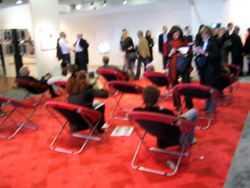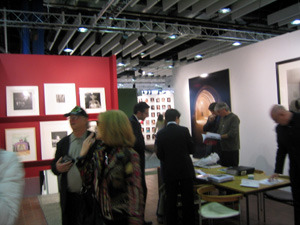The Business of Art: What Happens When the Bubble Bursts?
Collectors at the Armory Show (2005). Photo: Nick Stillman
Although the US economy has remained stagnant throughout the last several years, the market for contemporary art is booming. What accounts for this upturn, and will the art market crash like the dot-com stocks did in 2000?
Even the best professionals find it impossible to time the market. George Soros, one of history’s most successful hedge fund managers, loaded his portfolios with tech stocks late in the dot-com boom. He dumped them after the NASDAQ crashed in the spring of 2000. Later that year, after Soros had bailed out of the market, the NASDAQ regained 25% of its value. His funds took a thrashing from which they never recovered.
While I’m not as astute a market analyst as Soros and his portfolio managers are, I believe we’re currently experiencing a bubble in the contemporary art market that rivals the bubble in technology stocks seen in the late ’90s. When the bubble bursts—and it eventually will—the market for contemporary art will look very different than it does today. Emerging visual artists, as a result, will need to use new strategies for marketing their work to survive the change in environment.
I don’t have charts and graphs and historical pricing analyses to back up my belief that today’s contemporary art market is overheated. I’ll leave the technical analysis to the new breed of hedge fund managers who specialize in fine art portfolios. But my gut tells me the art market is due for a correction. Here’s why.
From alternative investment funds specializing in fine art, to corporations, to individual collectors around the country using the web to access gallery inventories and auction house catalogues, more people are buying contemporary art now than at any point in the past 15 years. This increased demand has significant market impact. Established galleries are selling out shows of mediocre work by well-known artists. Many of these middling pieces are flipped on the secondary market within two years, setting auction records. Prices are unsustainably high at the top end of the market right now.
Current levels of demand have implications lower on the food chain as well. Because non-established collectors are unable to get truly innovative work, they chase novelty. To meet this demand, smaller galleries snatch students from MFA and BFA programs and give them solo shows before they complete their degrees. Emerging artists today have more market opportunity than ever.

Collectors at the
Armory Show (2005).
(Photo: Nick Stillman)
Art fairs have played a role too, as they have become a movable feast for celebrating collectors and their dealers. When listening to WPS1 Art Radio’s dispatches from Art Basel Miami Beach last fall, I was struck by the similarities to what I heard at stock investor conferences in the late ‘90s: the enthusiasm and excitement, the self-congratulatory tone, the continual talk about the market’s strength, the absence of any acknowledgement of a potential for downside correction.
I attribute the market’s run up to a couple economic factors. Affluent collectors are feeling more flush today than they have in the past decade. The Federal Reserve has given us three years of artificially low interest rates, allowing collectors to build substantial home equity. Bush iced the cake by putting more money into their pockets with tax cuts.
These underlying economics, though, aren’t sustainable. As interest rates rise, real estate prices will sag. We’re already beginning to see softness in some Midwestern markets. With the US fighting the War on Terror at home and in the Middle East, the ever-increasing costs for homeland security, and promises of more healthcare giveaways to an aging population, Bush (or his successor) will be forced to increase governmental revenues by raising taxes. When these drivers are removed, interest in contemporary art will decrease at both the top end of the market and for emerging artists. Supply will exceed demand. The bubble will burst. It’s happened before. For those who have come of age in this period of strong market demand, Richard Polsky’s book I Bought Andy Warhol provides a good case study in how a sizzling hot art market can burn out within a matter of months.
When the market starts to cool, we’ll see several changes. Newer, smaller dealers will face cash flow challenges and will close their doors. Larger dealers who represent established artists will cut back. They’ll present more conservative and saleable work while they pay their bills through profits generated from private back-room deals. If these predictions come true, emerging artists will need to rethink how they bring their work to market and manage their careers.
Young artists should first focus on developing a voice. Rather than rushing their work to market as soon as they complete academic programs, artists will need to give themselves more time to work and develop a mature style. As the market becomes more selective and rewards innovation over novelty, it will value work by artists who drive toward multiplicity and richness rather than those who simply exhibit something new.
Young artists will also need to accept the fact that it will be more difficult to gain gallery representation. Artists who form collectives, hang shows in alternative spaces, and create their own buzz will be rewarded. Think of the success realized by Damien Hirst and his YBA peers during the last market downturn.
Finally, it will become even more important for emerging artists to steel themselves against disappointment. With fewer commercial opportunities, artists won’t be able to rely on the market for support and validation. Morale building will need to come through communities that artists build themselves—with other artists, with nonprofit spaces, and with collectors of their work.
A downturn in the art market won’t be enjoyable for anyone. But those who use different approaches to navigating a changed environment will succeed. They’ll be the ones who emerge well positioned to take advantage of the rebound when the pendulum swings back again.
Todd Gibson, a management consultant and art collector, edits the visual arts weblog From the Floor.




